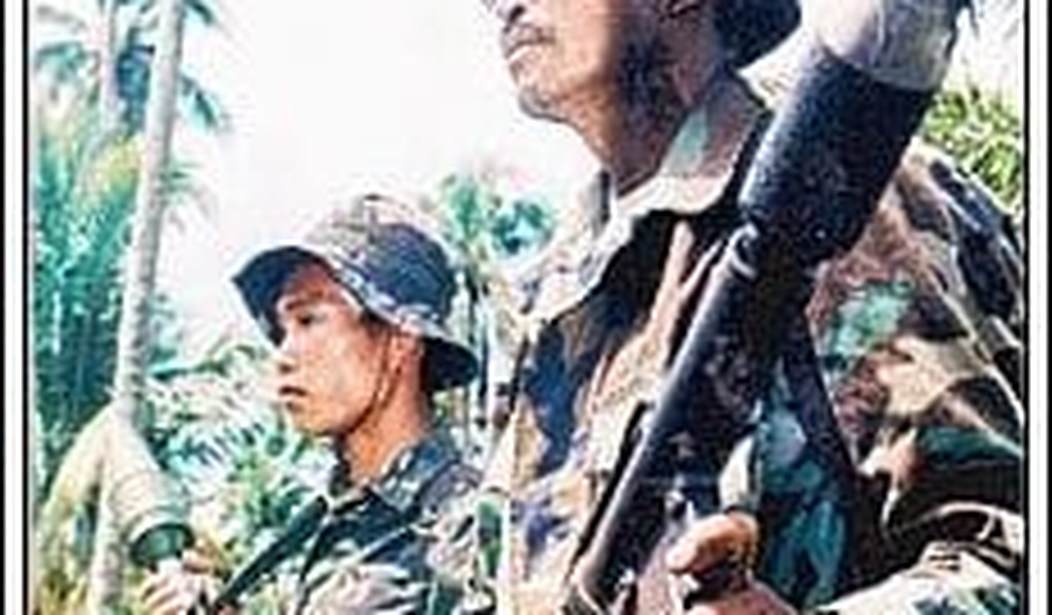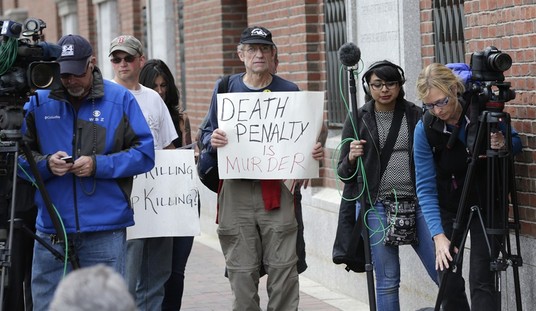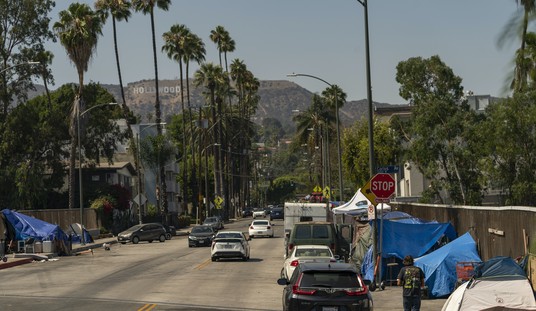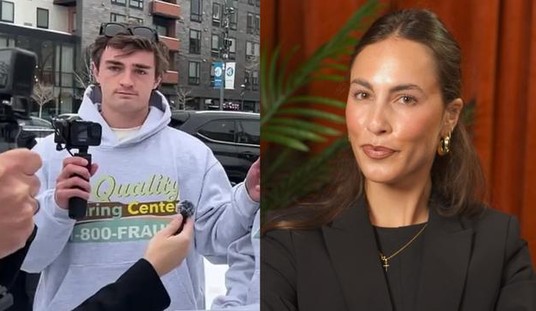Mindano: Theater of Operations
The ferry between two worlds at war.
The easiest way to get to one of the lairs of the Abu Sayyaf is to take the ferry to Basilan from Zamboanga city. The distance between the ethnically Christian Zamboanga peninsula and the largely Muslim (Yakan and Tausog) island of Basilan is about 20 nautical miles — a 45 minute trip on a 28 knot ferry. But today the distance between them in atmosphere is larger than physical.
American or European tourists can go about their business in Zamboanga, but Basilan is not considered safe. Locals said only one European was on the island; a German who had married a Muslim woman and was protected by her clan.
They say the desert is vast, but the sea is vaster. Many Muslims in the south are a sea-people, accustomed from early youth and conditioned by immemorial memory to live on the sea; and certain tribes actually build their homes on piles six feet above the high water mark. These descendants of the Moro pirates which assailed the Spanish forts tie up their outriggers like a horse to a hitching post at the foot of their homes at sea. The casual visitor to Zamboanga city will see Muslim families living on small outriggers; sleeping, eating and performing all the daily tasks that others are accustomed to on dry land.
Were you to walk the beach by night there would be lights moving beneath the waves. The traditional Muslim pearl diver has enlisted technology and evolved into the busero, a spear fisherman capable of staying forty feet below the surface half an hour at a time, sustained by a small plastic hose fed by an aquarium oxygen pump. With the slender source of oxygen like a straw between his lips, a waterproof flashlight in one hand and a rubber-band powered speargun in the other the busero‘s light attracts the curious fish beneath the harbor into lethal range.
The coastal areas of southern Mindanao are linked by the great highway of the sea with Basilan, the Sulu Archipelago and Muslim countries across the border. It is the highway of the hard man. And the hard men have been traveling this highway for centuries.
1.
The Lady in Blue of Fort Pilar
The year was 1720. The Spanish garrison at Fort Pilar in Zamboanga City in what would become the Phillipines lay asleep with only sentries keeping watch. According to tradition, in the hour before dawn, a sentry who had nodded off was awakened by the vision of a woman in a blue gown, since thought to be the Virgin Mary, who urgently told him: “Despierta. Hay Moros en la costa“, Arise. The Moros have come by sea. And indeed they had.
Dalasi, the King of Bulig had crossed from Basilan with a hundred ships. Three thousand kris-wielding Muslims closed in on on all sides of the fort to annihilate the Spaniards. Amid the noise of battle, a desperate council was held in the Spanish commander’s quarters. One priest volunteered to descend the walls by rope. He evaded the Moro pickets, stole one of Dalasi’s sailing vessels and made his way alone five hundred miles north to Manila to get reinforcements. Dalasi was killed and Fort Pilar beat back a two-month siege. The garrison’s survival was considered a miracle by the local community. But though that battle of Zamboanga was over the Moro war continued. It continues to this day.
Abu Solaiman
On January 18, 2007, Deutsche Presse-Agentur reported that “the United States hailed Thursday the killing of a senior Abu Sayyaf leader included in Washington’s most wanted list … Abu Solaiman. US Embassy spokesman Matthew Lussenhop said the US ‘congratulates’ the Philippines for the killing of Solaiman, 41, in a clash with government troops on Jolo island, 1,000 kilometres south of Manila.”;
Abu Solaiman had led a band of Moros which, like Dalasi the King of Bulig, raided an unwary coastal settlement — the Dos Palmas vacation resort in Palawan . There he kidnapped 21 people including Americans Guillermo Sobero and Martin Burnham, who were subsequently killed.
President Gloria Macapagal Arroyo said she was determined to “finish the job with a hand of steel against evil and to usher in a durable peace through economic development.” But if the mood in Manila over the end of the Moro insurgency was optimistic, among counterterrorism operators in the field the outlook was much darker.
Martin and Gracia Burnham, seized by
the Baathist-funded Abu Sayyaf
One field officer said: “There is little chance that we can get the Muslims to stop fighting by enticing them to a political settlement; and we don’t have the capability to defeat them militarily either.” Abu Solaiman was reported to have told Gracia Burnham, one of the kidnapped Americans who survived the Dos Palmas ordeal, “You are beyond price,” when she asked what if anything could be done to secure their release. “Your release cannot be negotiated.” Asked if peace would ever come the counterterrorist’s answer was blunt. “Maybe in two or three hundred years. But certainly not in my lifetime.
Until the mid-1990s the causes of the Islamic insurgency in the Philippines — and its solution — seemed clear enough. Spain and America, the predecessors of the Republic of the Philippines, had forcibly incorporated the Moro nation into its boundaries; and now the Republic could not hold on. The obvious political solution was to return a large part of it’s former territory to the Moros, at least as an autonomous region.
The initial inclusion of the Moro territories into the Phillipines was a product of history. Arab missionaries arrived in Tawi-tawi in 1380. By 1457, nearly a hundred years before the first Spaniards, the Sultanates of Buayan, Maguindanao and Sulu were established in lower Mindanao, and some colonies established as far as Luzon. The impulse of Spanish expansion, fresh from the Reconquista, had circled the globe only to come face to face with Muslims again on the other side of the world. Despite their weak numbers, the Spaniards laid claim to the territory of these sultanates but had failed to conquer them conclusively.
The Moro “Rebellion”
The Americans with their greater resources had done that job between 1899 and 1913. Ironically, the US Army, tired from their recent campaigns in Luzon had hoped to leave the Moros alone. But when American journalists learned of the slave-raids of the Muslims against “Christian” Filipinos, which the Spaniards were never wholly able to stop, US public opinion forced Leonard Wood to break the power of the Sultans. Wood substantially reduced the military power of the Moros.
Tasker Bliss consolidated Woods’ gains by creating a local constabulary. Finally John J. Pershing finished the job by rounding up the weaponry on which much of the former life depended – and smashing any resistance that came his way.
After that conquest, the US colonial authorities flooded Mindanao with Christian immigrants from Luzon under a homesteading system. To Moros, who before the arrival of the Americans had regarded Luzon and the Visayas as a source of slaves, this influx of immigrants was the ultimate reversal of fortune. By the 1930s the Moro nation seemed beaten down, apparently forever.
2.
Moro warriors today
But forever is a long time. By the 1970s, with Ferdinand Marcos attempting to seize absolute power in Manila, the Republic’s hold on the Muslim regions of Mindanao had weakened to the point where young Muslim militants, such as Nur Misuari, challenged Manila’s authority by retaking the Jolo, the capital of Sulu, which was recovered only by strenuous effort.
With support from Libya and Malaysia, which provided arms and training, the Muslim regions of Mindanao exploded and the modern Islamic insurgency had begun. A Time Magazine article from 1974 describes how the Muslims overran Jolo’s airport and took the 1st Army Brigade headquarters. It was recaptured only after the arrival of heavy weapons, including howitzers and combat jets from Manila.
Although Marcos beat back the initial attack, it weakened his hold over Luzon and the Visayas. In 1976, Marcos offered the Moros an autonomous region over 14 provinces; the right to sharia law; leave to create a system of religious education; control over local government; and a separate economic and financial system. The agreement, signed in Tripoli, Libya, was couched in the most obsequious terms. In the Name of God, the Omnipotent, the Merciful, the Tripoli Agreement began, and with the words done in the City of Tripoli on 2nd Muharram 1397 it ended. Marcos had bought his peace; but the concessions would not be enough.
Two developments snatched peace from the grasp of Marcos and the Presidents who succeeded him.
The first was the emergence in the 1990s of a radical form of pan-Islamism that replaced the old-style Moro nationalism of Nur Misuari. Its vision, as articulated by the Jemaah Islamiya (JI), was no longer to simply regain the status quo ante for Muslims in the Philippines. It was committed to creating an Islamic Caliphate across Asia and Australia. Radical cells began to break away from Muslim groups in dialogue with the Manila for whom any conceivable concession would be inadequate.
The second reason was warlordism and corruption. Moro society was built around the warlord-dominated clan. Neither Misuari, nor anyone else could persuade all the factions to enter into a comprehensive peace with Manila. “Whenever we seemed close to reaching an agreement,” one counterterrorist officer said, “a splinter group would split off and begin making separate demands”.
But handing control over the Autonomous Region for Muslim Mindanao (ARMM) to the warlords and the Muslim guerillas meant putting corrupt men in charge of the candy store. Misuari and his men were given billions of pesos in seed money and the extraordinary authority to accept funds from Islamic countries. Much of it vanished into a private billfolds without making an appreciable dent in the extreme poverty of the Moros.
Even cities within Basilan opted to stay within the mainstream administrative structure of the Philippines rather than with “their” autonomous region. “And well that they did. Any government employee who was paid through ARMM experienced a six-month delay in the payment of salaries.” The ARMM funds were siphoned off to ghost employees and collected by retainers of the warlords.
Sometimes it seemed like the Moro leaders were determined to keep their people in ignorance and poverty the better to control them. “I recall flying over a well-vegetated area over Sulu,” one official said, “and remarking how well the reforestation of the area was progressing.” The pilot dryly replied that the area below was marked on the map as the provincial highway. It had been completely overgrown with brush and vegetation, despite its completion on paper. “And anyway they liked it better that way because the brush would provide cover in the next round of fighting. It was always about fighting and planning for the next round of fighting.”
3.
The recently killed Abu Solaiman was the embodiment of all these trends. A civil engineer by training, who in his student days in Zamboanga had been a keen basketball player, Solaiman was offered a responsible position in the Philippine government under the policy of attraction. The Philippine Star described what happened next:
The military said Solaiman had worked with the government in the defunct Southern Philippines Development Authority (SPDA) in the early 1990s. Solaiman reportedly siphoned away the SPDA’s budget of P1 million and fled to Saudi Arabia where he was later recruited by agents of al-Qaeda chief Osama bin Laden.
Solaiman began his activism by joining the Moro National Liberation Front (MNLF), a Muslim separatist group that signed a peace accord with the government in 1996. He broke off from the MNLF when the accord was signed and decided to work in Saudi Arabia for a few years building highways and buildings, according to police intelligence reports. In the late 1990s, he returned home and joined the Abu Sayyaf.
Despite the apparent failure to achieve any political settlement with the Moros, Filipino military men tried to make things work, often on the basis of personal friendships with individuals in the opposite camp. For example, when counterterrorist intelligence learned that Jemaah Islamiyah cadres were being trained in terrorist skills in a Moro Islamic Liberation Front area, they hesitated to raid the site because the Moro Islamic Liberation Front was a officially a “peace partner” of the government.
A Filipino intelligence official attempted to square the circle by persuading his Muslim contacts in the MILF to attack the JI camp with government sanction. Asked whether this may have tipped the JI off into escaping, the official said “That was a risk, but what else was there to do? The official policy is to pursue a political settlement whether anyone really wants it or not.” But if the chance of a comprehensive political solution seemed distant (“They’ll solve the Israeli-Palestine problem before we solve this”) a military solution seemed equally remote. “When Armed Forces of the Philippines campaigned through Central Mindanao in 2000 after peace talks broke down the Philippine Armed Forces were using up ten million pesos ($200,000) of munitions a day. In a few weeks we had burned through the whole year’s budget. We kept going a few days longer only because some officer had figured out a way of bartering Philippine pineapples for Pakistani-manufactured 155mm artillery rounds and small arms ammunition.”
Guns or pineapples and neither worked. That was the bind. Marcos had negotiated the Tripoli Agreement because he could not afford to enforce a military solution. So a political solution was pursued instead, even if it went nowhere and made any future military solutions more expensive to a country which could not afford them in the first place.
4.
With both military and political solutions at a dead end, what was there left? “Getting the hell out,” the counterterrorism official said, “I spent years in this region and I’m tired of getting my cellphone message box filled with death threats. What I want is some of my life left.” Asked if higher headquarters and the political bigwigs in Manila understood the gravity of the situation he answered, “Why should they care? All they care about is the circuses that get them elected.” Then he added ominiously, “They don’t think there’s a threat to Manila, but I tell you there is. There’s a supply of Muslim converts among overseas workers flowing back from Saudi Arabia. Filipinos working there are pressured to accept Islam. Sometimes they are even offered money. And as to threats the big one may be coming.” To hear him tell it, the Rajah Soliman Revolutionary Movement, consisting largely of converts and which had Jemaah Islamiyah connections, were planning to explode a large bomb in Manila. “They were aiming for a one-ton bomb. We took down a safehouse in Fairview in Manila with 600 kilos of ammonium nitrate explosive in 2005. They were that close.”
The Mindanao-based counterterrorism official echoed a conversation I had with a senior policeman in Manila. The metropolitan cop thought a spreading network of Islamist cells in Luzon and the Visayas meant that radical Islamic terrorists could now operate in traditionally Christian parts of the Philippines. “I’ll say one thing more. We’ve observed technical exchanges between the Communist New Peoples Army and the Islamist rebels.”
In the view of some counterterrorism officials the threat was growing — or at least deepening — with the passage of time. “The Christians in overwhelmingly Muslim areas like Sulu and Tawi-tawi are moving out. Terror is working; ethnic cleansing is succeeding.”
“In Central Mindanao, where the Muslims were not a majority, they apparently wanted 1,000 local government units (barangays) transferred to their authority where they were only in the majority in 200. With so many Christians and a lot of loose firearms there, the Cabinet was warned that a sell-out might provoke the formation of militias. “So the politicians in Manila will stall. That’s what politicians do. Stall and leave the whole mess to the next office holder to solve.”
Tomorrow: Part 2 of Islands in the War
Richard Fernandez is the Sydney editor of Pajamas Media. His writings can also be found at The Belmont Club.










Join the conversation as a VIP Member